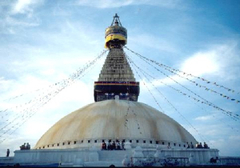Prayer to the Three Stūpas
༄༅། །ནཻ་པ་ལའི་མཆོད་རྟེན་རྣམ་གསུམ་གྱི་གསོལ་འདེབས་བཞུགས་སོ། །
A Prayer to the Three Stūpas of Nepal
by Jamyang Khyentsé Chökyi Lodrö
ཨེ་མ་ཧོ། དུས་གསུམ་སངས་རྒྱས་རྣམས་ཀྱི་བྱིན་གྱིས་བརླབས། །
emaho dü sum sangye nam kyi jin gyi lab
Emaho! The blessings of the buddhas of the three times,
སྤྲུལ་པའི་རིང་བསྲེལ་འཛད་པ་མེད་པའི་གཏེར། །
trulpé ringsel dzepa mepé ter
An inexhaustible treasury of miraculous relics,
ཆོས་སྐུའི་མཆོད་རྟེན་འཕགས་པ་ཤིང་ཀུན་ལ། །
chökü chörten pakpa shing kün la
The dharmakāya stūpa of Svayambhūnāth1—
མི་ཕྱེད་གུས་པ་ཆེན་པོས་གསོལ་བ་འདེབས། །
miché güpa chenpö solwa deb
With unshakable devotion, to you I pray!
སངས་རྒྱས་འོད་སྲུང་མཆོག་གི་བྱིན་རླབས་ལས། །
sangye ösung chok gi jinlab lé
Through the sublime blessings of the Buddha Kāśyapa,
མཁའ་འགྲོ་བདེ་མཆོག་སྲས་དང་བཅས་པ་ཡིས། །
khandro demchok sé dang chepa yi
The ḍākinī Samvarī and her sons,
ལེགས་པར་བཞེངས་པའི་མཆོད་སྡོང་ཆེན་པོ་ནི། །
lekpar zhengpé chö dong chenpo ni
Built this great stūpa to perfection—
འཕགས་པ་བྱ་རུང་ཁ་ཤོར་ལ་གསོལ་བ་འདེབས། །
pakpaja rung khashor la solwa deb
Noble Jarung Khashor, to you I pray!
བྱང་ཆུབ་སེམས་དཔའ་སྙིང་སྟོབས་ཆེན་པོ་ཡིས། །
changchub sempa nyingtob chenpo yi
From the relic remains of bodhisattva Mahāsattva,2
སྟག་མོར་སྦྱིན་པའི་སྐུ་གདུང་ལྷག་མ་ལས། །
takmor jinpé kudung lhakma lé
Who offered his body to the tigress,
བསྐྲུན་པའི་བསོད་ནམས་ཞིང་མཆོག་མཆོད་རྟེན་ལ། །
trünpé sönam zhing chok chörten la
Arose this stūpa, a supreme field of merit3—
དད་པས་ཕྱག་འཚལ་གུས་པས་གསོལ་བ་འདེབས། །
depé chaktsal güpé solwa deb
To you, with confidence I prostrate and with devotion I pray!
ལུས་དང་ལོངས་སྤྱོད་དུས་གསུམ་དགེ་ཚོགས་བཅས། །
lü dang longchö dü sum gé tsok ché
My body, my possessions and all the virtue I gather throughout the three times,
ཀུན་བཟང་མཆོད་པའི་སྤྲིན་དུ་འབུལ་བ་དང་། །
kunzang chöpé trin du bulwa dang
All of them, I offer, as Samantabhadra’s offering clouds!
ཕྱག་འཚལ་སྡིག་བཤགས་ཡི་རང་ཆོས་བསྐུལ་ཞིང་། །
chaktsal dikshak yi rang chö kul zhing
I prostrate, confess my misdeeds, rejoice, and request the Dharma and pray that you remain—
བཞུགས་གསོལ་དགེ་ཚོགས་བྱང་ཆུབ་ཆེན་པོར་བསྔོ། །
zhuk sol gé tsok changchub chenpor ngo
Through this accumulation of merit, may we attain the great awakening!
བདག་གཞན་སྐྱེ་དང་ཚེ་རབས་ཐམས་ཅད་དུ། །
dakzhen kyé dang tserab tamché du
May I and others, throughout all our lives,
མངོན་མཐོའི་རྟེན་ཐོབ་ངེས་འབྱུང་ཚུལ་ཁྲིམས་དང་། །
ngön tö ten tob ngejung tsultrim dang
Attain a rebirth in a higher realm! May renunciation, discipline,
བྱམས་དང་སྙིང་རྗེ་བྱང་ཆུབ་སེམས་མཆོག་དང་། །
jam dang nyingjé changchub sem chok dang
Love, compassion, supreme bodhicitta,
ཡང་དག་ལྟ་བ་རྒྱུད་ལ་སྐྱེ་བར་ཤོག །
yangdak tawa gyü la kyewar shok
And the authentic view awaken in our minds!
སངས་རྒྱས་བསྟན་པ་དར་ཞིང་རྒྱས་པ་དང་། །
sangye tenpa dar zhing gyepa dang
May the Buddha’s teachings spread far and wide!
འགྲོ་རྣམས་བདེ་སྐྱིད་འཕེལ་ཞིང་རྒྱུད་པ་སེལ། །
dro nam dekyi pel zhing gyüpa sel
May beings’ happiness and joy increase and their misery be dispelled!
བསྟན་ལ་གནོད་པ་ཐམས་ཅད་རབ་ཞི་ཞིང་། །
ten la nöpa tamché rabzhi zhing
May all harm to the teachings be completely pacified!
བསྟན་འཛིན་སྐྱེས་རྣམས་ཞབས་པད་བརྟན་གྱུར་ཅིག །
tendzin kyé nam zhabpé ten gyur chik
And may the lives of the holders of the teachings be ever secure and stable!
ཅེས་པའང་ཆོས་ཀྱི་བློ་གྲོས་པས་བྱ་རུང་ཀ་ཤོར་མདུན་དུ་བྲིས་པའོ།། །།
This was written by Chökyi Lodrö in front of the Boudha Stūpa, Jarung Khashor.
| Samye Translations, 2017. (Translated by Peter Woods and Stefan Mang. Revised 2018, with many thanks to Hubert Decleer.)
Source:
'Jam dbyangs chos kyi blo gros. "ne+e pa la'i mchod rten rnam gsum gyi gsol 'debs/" in ’Jam dbyangs chos kyi blo gros kyi gsung ’bum. 12 vols. Bir: Khyentse Labrang, 2012. W1KG12986 Vol. 10: 391–392
Version: 2.2-20241001
- ↑ The Tibetans refer to Svayambhū as Pakpa Shingkün ('phags pa shing kun), Sacred All-Trees. On this, see Hubert Decleer, “The Tibetan Name of Svayambhu, 'Phags pa shing kun ('Sacred All-Trees'): What Does it Really Mean?” in Light of the Valley: Renewing the Sacred Art and Traditions of Svayambhu, edited by Tsering Palmo Gellek & Padma Dorje Maitland (Cazadero, CA: Dharma Publishing, 2002): 241–272.
- ↑ In his life prior to attaining awakening, Buddha Śākyamuni was the bodhisattva Mahāsattva, ‘the Courageous,’ who offered his body to a hungry tigress.
- ↑ i.e. the stūpa of Namo Buddha
